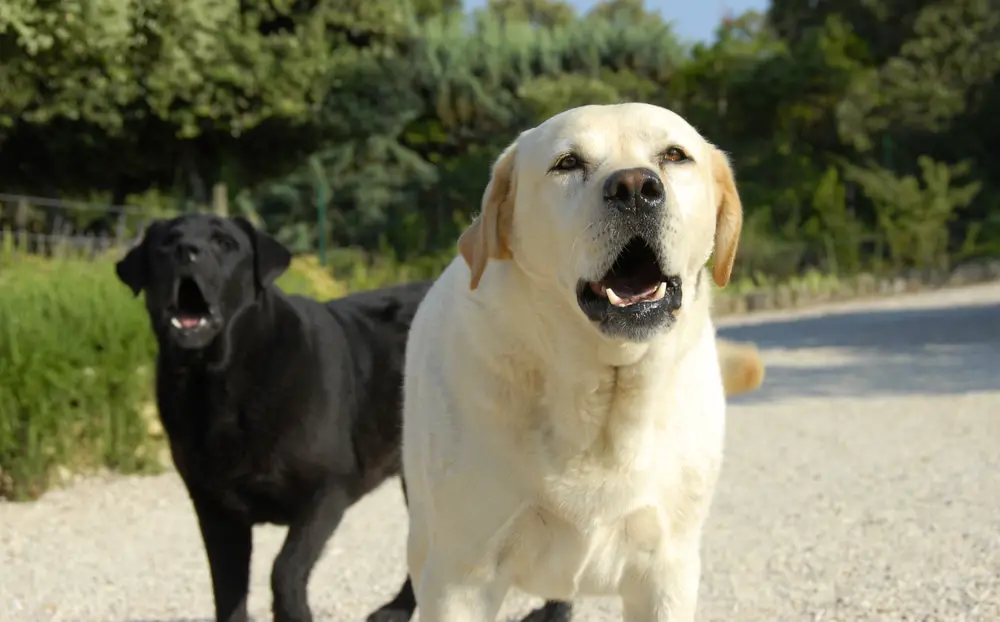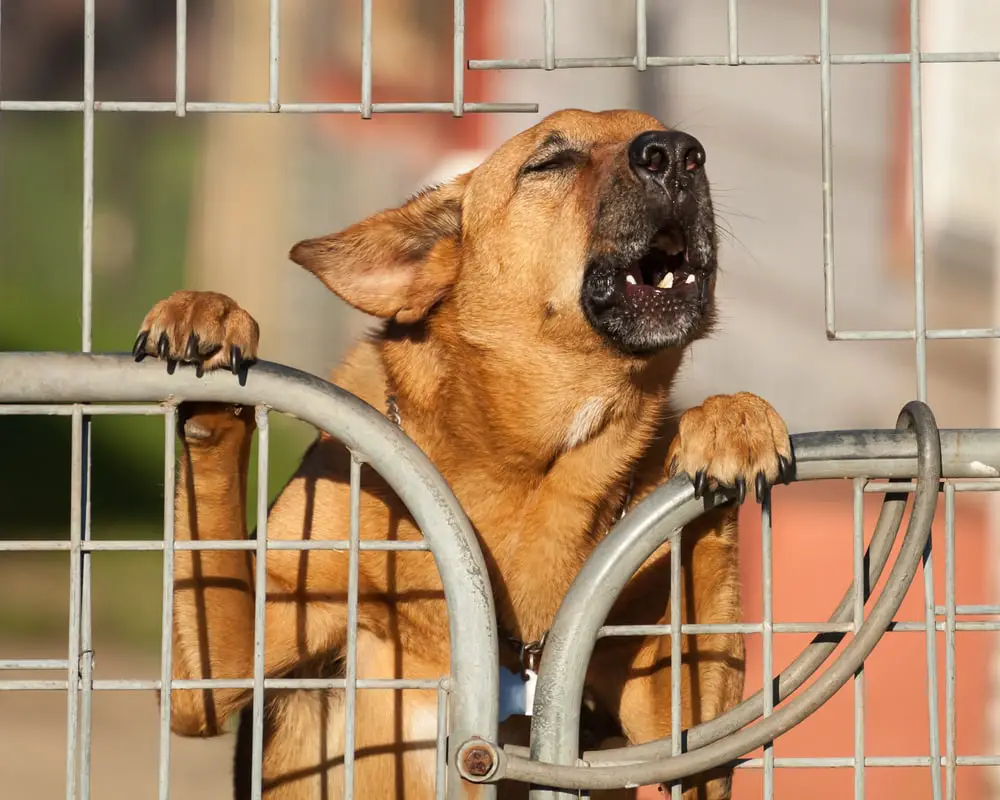Your kids are about to head off to school, bookbags, and lunches in hand.
As they near the door on the way to the bus stop, you give them each a big hug and tell them to have a good day, but their muffled responses are clouded by your dog, who seems to be fiercely barking at you for no reason at all.
The same happens when you go anywhere near your husband or even try to pick up the dog’s toys – incessant barking that sometimes can feel a bit frightening if you’re being completely honest.
What gives? Is it possible that your dog doesn’t like you?
Not at all. What’s happening here is often referred to as dominance or socialization aggression. It’s not that he doesn’t like you, but he may view you as inferior to his own role in the home.
Why does your dog bark at you, but not your husband? Your dog barks at you but not your husband because he sees himself as being of high status in the “pack” that is your family. Dogs naturally create a hierarchal order in the wild, living in packs or groups who share food, space, and protection. The pack has a leader, a few others who hold a high rank, and those who are at the lower end of the social order deemed weaker or more vulnerable than the rest. Each member knows his place. And, in this case, your dog views you as being lower in the order of relationships, barking at you to reinforce his position, and let you know of yours.
While this makes perfect sense, it certainly isn’t optimal. Human-to-dog relationships are more complex than social packs in the wild, but a dog who perceives himself to be as high in status as the leader of the pack or just below will often react aggressively toward other members of the family, especially if he feels the need to be protective or enforce his position (source).
Nonetheless, this type of behavior can be startling at best. There are ways to address these behaviors with your dog, which we will discuss further. But first, it’s important to understand the reason behind your dog’s barking, and how dogs grow to perceive their role in your home (source).
Why Do Dogs Bark?

Asking why dogs barks may seem like a silly question, but part of correcting your dog’s behavior requires an understanding of the reasoning behind the behavior (source). In this case, the barking or perceived aggression toward one member of the family.
Because barking is your dog’s way of communicating, he does so to express that there is something he wants, needs, or simply doesn’t like. You may notice that your dog also communicates with different degrees or tones in his bark or changes in body language.
If you think about a baby’s cries, you’ll often hear parents say that they are able to distinguish what the child wants based on the different cries they hear. A cry for food sounds different from a cry expressing frustration or exhaustion.
The same applies to dogs. A dog’s bark communicates different feelings, wants, or needs.
Different types of barking can include each of the following (source):
- Protective barking – perceived danger
- Territorial barking – guarding your home
- Alarm – someone approaching your property
- Greeting – saying “hello”
- Socially facilitated barking – hearing another dog bark
- Frustration – something is bothering him (a toy is just out of reach, for example)
- Compulsive barking – some dogs simply bark excessively, depending on the breed
- Attention-getting – wants to play, etc.
It is not necessarily the case that you’ll always be able to differentiate your dog’s tone in his barking, but you will be able to notice nuances in both barking and body language that will help you to understand what he is trying to communicate.
Reasons Why Dogs May Bark at One Member of the Family
As we mentioned earlier, one reason behind your dog’s barking is that he views members of your family as part of his pack, and in his mind, he has reserved for himself a position of higher rank – higher than you, though perhaps lower than your husband. He may even view your husband as the pack leader.
At times, he may be barking in a territorial or protective manner in response to something you may be doing.
His barks may be signaling that he is protecting his environment, which can be both people and places, as well as objects (source). He may also be protecting his status, showing you that he feels that he needs to reinforce his role in the hierarchy (source).
Even when your dog is not in a protective stance, he will continue to emphasize the boundaries he has set up in his mind about his role and status in the pack versus yours (source).
Simple things like disturbing him in his sleep or taking away a toy or food may be perfectly acceptable for your husband, but when you do those same things, your dog’s barking is meant to communicate and remind you not to overstep your rank.
Dogs often do this with one another, displaying aggression in an effort to reinforce pack roles (source).
This type of behavior is often referred to as social or dominant aggression and the reason behind your dog’s barking and assertive behavior.
Barking as a Result of Dominance or Social Aggression
Dominance aggression can be defined by aggressive tendencies displayed when your dog feels as though there is a challenge to his social status or control of social interaction (source).
Dogs who display social or dominance aggression can be very friendly, affectionate dogs on one hand, but aggressive when they feel that a person has overstepped his or her boundaries (source).
This type of aggression is generally directed at one family member and is one of the most common reasons why dogs bite their owners (source).
Overstepping boundaries can range from hugging a family member your dog feels he needs to protect to bumping your dog, who is fighting to get to the door before you. It may also include the following:
- Taking food, toys, or bones away
- Disturbing the dog while he sleeps
- Moving your dog from his favorite spot
- Grooming or nail trimming
- Physical restraint (even “friendly” restraint)
- Putting on a leash, harness or collar
- Reaching over the dog
- Touching the dog’s ears or feet
- Verbally or physically scolding the dog
How do Puppies Learn their Place in the Pack?
Young puppies are rarely socially aggressive in an effort to display dominance.
This is more likely learned behavior that develops somewhere between one to three years old, depending on his breed, life in the litter, and how you’ve interacted with him (source).
Interestingly, there is some evidence that shows that dogs may display a more dominant personality early, depending on whether they prefer to use their right versus left paws – or, whether they use both equally.
Next time you watch your puppy play, see if he places his right paw or left paw over the toy to hold it in place – this will give you an indication of his paw preference.
You can read more about paw preference and how some dogs use their paws in the article titled, “Dog Breeds Who Use Their Paws A lot.”
Puppies who are trained to recognize that their position is at the bottom of the pack are less likely to challenge others for control or leadership, whether person or animal.
With that in mind, it may be the case that the way you interacted with your dog as a puppy differed from that of your husband, and in doing so, your dog took the lead.
Another consideration is that some dogs, like humans, are natural leaders while others are perfectly happy to take on positions of lower status (source).
In the same way, some dogs have higher thresholds in dealing with what they perceive to be a threat, while others are more prone to bite even with the smallest provocation. This is generally dependent upon both genetic and environmental factors (source).
If your dog is displaying aggression of this nature, there are behavioral modification techniques that may help, but it is vitally important that you do not yell or hit your dog in an attempt to challenge his behavior or teach him to obey.
This will do little more than cause your dog to distrust you and make the aggression worse.
You can read more about behavior modification in puppies who are beginning to express dominance through biting or nipping in the article entitled “How to Get Your Puppy to Stop Biting You, Even When You Feel Like You’ve Tried Everything.”
A Pack Leader Dog – And What to Do About It
Unfortunately, a pack leader dog is one who has decided that he will make his own decisions, regardless of your commands.
He will not do anything he does not want to do (so trying to force him into submission will result in more aggressive behavior).
He will also often want to be the center of attention (source). Again, depending on personality, some dogs are simply more likely to attempt to establish themselves in this way.
Establishing yourself as a pack leader does not mean taking on an authoritarian role or scolding your dog incessantly to force him into inferiority.
It is more about understanding your dog’s personality, temperament, and mannerisms, and showing your dog that you are superior in areas that are important to him, such as winning games and playing, feeding times, sleeping places and territory, as well as attention (source).
Winning games while playing
Sure, we’ve all played tug-of-war with our dogs and let them win by allowing them to hold onto the toy. But this is just one example of how we teach our dogs that they are the leader of the pack – by winning.
When playing tug-of-war games with your dog, one important rule is to win more than you lose.
Doing so will teach your dog where his position is in the pack. Certainly, let him win from time to time – otherwise, he will not want to play with you – but remember: win more than you lose (source).
Taking toys away except at playtime
Another fairly easy trick is to take toys away after you are finished playing. Some toys are reserved as your dog’s toys and left out all of the time.
But others, especially those that you use to play ball or tug-of-war, should be taken away at the end of playing time. Doing so will also teach your dog that final possession of these toys belongs to you, again reinforcing your role as higher-ranking status (source).
Sleeping and resting spots
It’s pretty tough to avoid letting your dogs in your bed with you or on the couch. However, if your dog is displaying territorial aggression, it is a good idea to control where your dog sleeps.
Often, dogs who view themselves as higher-ranking choose spots that are higher up so they can “look down” at others in the pack – this includes furniture as well as your bed.
If your dog is particularly prone to dominance aggression, it may be a good idea to keep him away from some of these areas, at least at the start (source).
Doorways and entrances
Because dogs view doorways and entrances as the beginnings of new territory, they will often try to go through before you in order to establish their role as the leader.
Avoid allowing this to happen, even if you must leash your dog to make him wait until you’ve gone through the entranceway first (source). It may seem silly to you, but for your dog, it’s something he views importantly.
Order of feeding
Another consideration is that dominant animals in the pack eat first in the wild. Subordinate animals get what is left after those of higher rank have already eaten (source).
Maintaining your role as pack leader means that your family eats first, and then you feed your dog. It also means avoiding giving scraps from the table.
Attention seeking behavior
All dogs want and need attention. It is important that you give your dog attention when he is not seeking it, and that you also do not give him attention when he is incessantly barking or crying for attention at a time that may not be optimal for you.
This does not mean you simply ignore your dog. Quite the contrary. The idea here is that you are the one initiating attention and even playtime.
It is a great idea to initiate playtime with your dog with the toys that are generally kept out of his possession (tug-of-war toys, for example).
One additional note about attention-seeking is that if your dog is barking at you while you are affectionate with your husband or children like we mentioned in the beginning, it is important that the other members of your family do not reinforce this behavior by giving him added attention.
This may require a firm “no” (not loud, and not yelling or physically scolding) – but a firm response or potential time out until he calms down.
There are other reasons why dog barks, identify each one of them in this short video below:
Things to Avoid when Addressing Aggressive Behavior

There are a lot of things you can do to help a pack leader dog change his behavior, but one thing will nearly always make it worse – punishment.
Any effort to “dominate” an already dominantly aggressive dog will only cause him to take your dominance as a challenge, resulting in further (or worse) aggression.
Often, punishment may seem like a quick fix, but in reality, it is only temporary. In the short term, your dog may discontinue the behavior. In the long term, however, aggressive punishment tactics will only lead your dog to perceive you as a threat, worsening his behavior over time (source).
This is why positive behavioral modification techniques are best, including rewards for the behaviors you do want to see, especially in the areas mentioned in the above section.
For example, as your dog learns to wait to go through a doorway until you have passed, reward him for doing so each time. This will reinforce the behaviors you want to see, and over time, he will naturally wait for you to go through first.
The idea is to reinforce behaviors that your dog begins to understand will result in a positive outcome or reward (source).
Another important reminder is to avoid encouraging aggressive behavior with tug-of-war games and playtime.
He will continue to try to “win,” and you want to be sure that the scale is tipped in your favor, meaning most of the time you win, while allowing him to win only on occasion so that he continues to enjoy the game (source).
Final Notes about Dominance Aggression and Where to Seek Help
If your dog continues to exhibit dominance aggression, it may be a good idea to seek help from your veterinarian or a professional who is skilled in training aggressive dogs.
Your veterinarian can also the first rule out any medical causes for aggressive behavior if applicable, and even help you to determine what steps to take next. A professional will better be able to help modify your dog’s behavior and keep everyone safe in the process.
Another tip is to be sure to avoid exposing your dog to situations where he is more likely to show aggression. If he is visibly uncomfortable, help to either remove him from the situation or avoid it altogether.
And finally, spay or neuter your dog. Doing so will lessen the degree to which your dog is likely to exhibit dominance or aggressive behavior (source).
**Dog barks back when scolded? Find out what you can do in this guide here!**
Final Thoughts
Remember, a dog who barks at you and not your husband does not inherently dislike you. He is simply confused about his role in the pack versus yours and is attempting to either challenge you or reinforce his position.
With help from a trained professional, and continuing to make changes to the way that you interact with your dog, it is possible to change your dog’s behavior and his understanding of his role in the family, resulting in a much happier household, both for you and for your beloved pet.


0 Comments